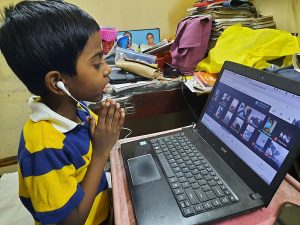During his visit to India in early April, the World Bank’s Global Director for Education Jaime Saavedra drew attention to the grave crisis in India’s school education sector in the aftermath of the COVID-19 pandemic. “In India, learning poverty has shot up from 54 percent to 70 percent,” he said. The World Bank defines learning poverty as the inability of children to attain minimum reading proficiency and correlates this with the proportion of children who are out of school.
The crisis in India’s education sector is accentuated further by the alarmingly high dropout rates. As per the Indian government’s Unified District Information System for Education Plus (UDISE), 2021 report, the annual dropout rate of secondary school students in the country was 14.6 percent.
As Saavedra pointed out, COVID-induced school closures had a “gigantic impact” on children and India figured prominently in this “global crisis” since it has such a large child population. One out of every five children in the world is from India.
There were inequalities in education already, and these were exacerbated by the pandemic.
What made matters worse were the long lockdowns to contain the spread of the coronavirus. The Indian government imposed the second-longest pandemic-linked school closures in the world, behind only Uganda. UNESCO estimated the closure to be approximately 82 weeks, impacting India’s 250 million children in 1.5 million schools.
It is imperative to highlight that girl children have been more adversely impacted than boys, with dropout rates among females alarmingly high. A UNICEF India U report poll found that 38 percent of the respondents knew at least one female student who had dropped out of school.
Apart from loss in learning, when children drop out of school it leads to a spike in child labor, as well as child marriage and child trafficking for girl children. The economic distress in the wake of the sudden unplanned lockdown forced many children to take up jobs to supplement the family income. Several surveys conducted since 2020 have unsurprisingly indicated a setback in the country’s social development indices.
With the onset of the pandemic, teaching went online and children were expected to attend online classes. Nearly 70 percent of India does not have access to internet connectivity, according to a Parliamentary Standing Committee report. Accessing online classes was therefore extremely challenging for many children. According to the School Children’s Online and Offline Learning (SCHOOL) survey, which was conducted by economist and activist Jean Dreze and his team primarily among underprivileged sections, 37 percent of children in rural areas are not studying at all, while only 8 percent are studying in the online mode regularly. The report describes this as the “fiction of online education.” The scenario is worse among children from marginalized communities like Dalits and Adivasis (tribals) with 43 percent of Adivasi children not studying at all.
Significantly, the digital divide is more acute for girls than it is for boys, since in most cases smartphones are owned by male family members, fathers and brothers. Accessing a phone to attend online classes is not easy for girls. Even if they have a phone, attending virtual classes regularly from home becomes difficult with the increase in domestic chores for adolescent girls.
Anjela Taneja, an educationist and member of the Right To Education (RTE) forum, told The Diplomat, “After the RTE act was enacted, it was expected that all children between the ages of six to 14 years will receive free universal elementary education, but due to the pandemic, that has been compromised.” Taneja who is also the convener of the Fight Inequality Alliance India, pointed out, “Survey after survey has proved that online teaching clearly excludes poor and historically marginalized communities, with only 4 percent Adivasis able to access it. Despite that when governments continue stressing on it, then it shows that they just don’t care.”
Schools are not just vehicles for delivering education; they are often the only place where poor and marginalized children get healthy nutrition through the mid-day meal provided there. The closure of anganwaadis, government-run childcare centers that cater to children below six years of age, deprived these children of essential pre-primary level schooling, nutrition, and healthcare needs. Schools are also the means of providing holistic development for the adolescent girl child, through health check-ups, counseling, and guidance, as a safety shield from the traps of child marriage and forced labor.
According to a study by the Azim Premji University, 92 percent of children lost at least one specific language ability and 82 percent lost at least one mathematical ability during the lockdowns. The question is whether “teachers are prepared to deal with students who have had no education for two years,” observed Taneja.
Education experts are unanimous in their view that schools can no longer be shut down and must remain open at all cost. The damage to children and thereby the country’s future is too high to risk school closures with every successive wave of the pandemic.
What needs to be done instead is to equip schools with the wherewithal to deal with the new pandemic reality – repair school buildings, have adequate wash and sanitation facilities, and provide access to medical care. At the same time, authorities need to revamp school curricula to reflect the current needs of students, train teachers adequately, have systems in place to identify out-of-school children and ensure they return to school.
It is imperative that the government acts to control the damage done by the pandemic to school education. This will require greater investments in government and public school systems to combat the present crisis in the education sector.

































